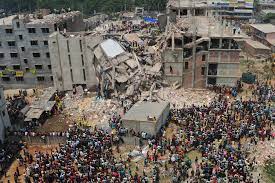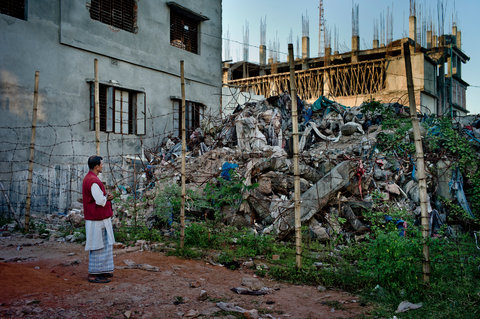The Human Cost of Labor Exploitation
By Josie Bixler
On April 23, 2013, gaping schisms ripped through the walls of Rana Plaza, an eight-story manufacturing building in Bangladesh.
An engineer was hired to assess the building’s integrity and reported Rana Plaza be immediately condemned. The 3000+ employees working at Rana Plaza were told to leave early for the day, according to a New York Times article.
The morning of April 24, garment factory floor managers ent from home to home to ensure employees were getting ready to meet the day’s quota. Workers reported feeling uneasy about their safety, but were more afraid of losing their jobs, according to an article from CNN. Jobs that only paid $0.32 an hour — $68 a month, a New York Times article reported.
The garment factories on the third through the eighth floor slowly filled and machines began to hum as clothing items were sewn for Western corporations such as Walmart, Lord and Taylor, Primark and The Children’s Place, among others, according to an article from Independent. Oddly enough, the banks and offices that made up the first and second floors, as well as a shopping mall on strike, remained closed.
Around 9 a.m., the power cut off, and as the backup generators began to rumble, the groaning of corroded metal shook the building. The air was heavy with white dust, a New York Times article reported.
It took 90 seconds for eight stories to collapse, one on top of the other. A minute and a half to kill over 1,100 people and severely injure over 2,500, a New York Times article reported.
- The aftermath of the Rana Plaza disaster. *Image from the New York Times
- A man stares at the ruins of what was Rana Plaza. *Image from the New York Times
- Rescue workers search for bodies in the rubble. *Image from the New York Times
It was later discovered that the top four floors were additions to the original building with no support walls or beams, according to an article from National Geographic. The floors couldn’t support the weight of the machinery they were built to hold. The fast fashion industry in America and Europe, demanding more and more clothes at lower and lower costs, ended up paying the price in hundreds upon hundreds of human lives.
But that was seven years ago. Hopefully, labor practices have changed since then.
During the days immediately following the Rana Plaza tragedy, Sohel Rana, the owner of Rana Plaza and one other garment factory, and 37 others, were charged with murder that could result in the death penalty. The murder trials have not started yet due to delays in the court system, but Rana was sentenced to three years in prison for unreported income, according to an article from Grow Ensemble.
In 2015, Rana Plaza survivors were given $30 million in settlements, although many did not receive any of the money and those who did used it for medical treatments. There was not enough compensation to make up for the permanent injuries that had prevented many Rana Plaza survivors from working and providing for their families, according to an article from Reuters.
Due to public outrage, over 200 corporations signed a legally binding Accord on Fire and Building Safety that was supposed to ensure all safety violations were rectified and would maintain safety measures for all future production, reported in the article for New York Times. That accord expired in 2018.
A New York Times investigative reporter found over 65 safety violations while sweeping through some of the garment factories still standing in Dhaka, Bangladesh, a few months before the accord was set to expire. The accord was an appeasement offering for the thousands of deaths these corporations were complicit in, but after media attention dwindled and the world’s eyes moved elsewhere, production returned to the way it had been. The conditions perfectly set for another Rana Plaza disaster.
Since the accord expired three years ago, there has been over 110 workplace accidents in the Dhaka region. With countries in lockdown due to the COVID19 pandemic, 2020 marked one of the worst years for labor exploitation and trafficking. Individuals were at higher risk and more vulnerable because of isolation and financial need.
The Polaris Project reported that the number of likely labor trafficking victims could have jumped up as much as 70% in 2020 alone and the United Nations Office on Drugs and Crime reported that over the last decade the number of child trafficking victims has tripled. In the seven years since the Rana Plaza disaster, exploitation is at an all-time high.
But there is hope.
Exploitation may be on the rise, but at no other point in human history has there been as many people willing to stand against slavery and coercion, according to a Girl Set Free partner.
For those willing to take a stand for freedom there are five action steps that can help prevent another Rana Plaza disaster.
- Support companies and organizations with transparent and ethical practices.
- Give donations and support to organizations intercepting, rescuing and restoring hope to victims of exploitation or trafficking.
- Raise awareness about fair labor practices through education.
- Support legislation that protects employee rights to fair wages, safety and treatment.
- Volunteer your time and talents to fight against exploitation.
Through consumer awareness, education and action business owners, corporations and governments can be held accountable so that tragedies like Rana Plaza won’t even be possible. It starts with one person deciding to do the right thing, and the ripple effect can last generations.
*Cover image is from the New York Times



Advocacy, Human Trafficking, labor trafficking, Monitoring, News, prevention